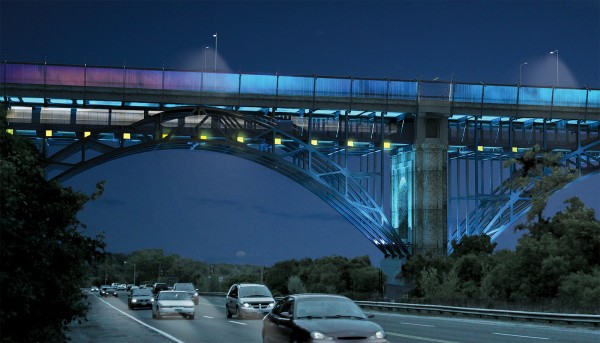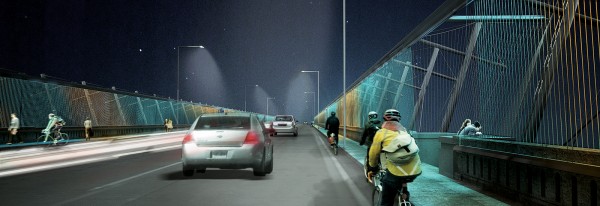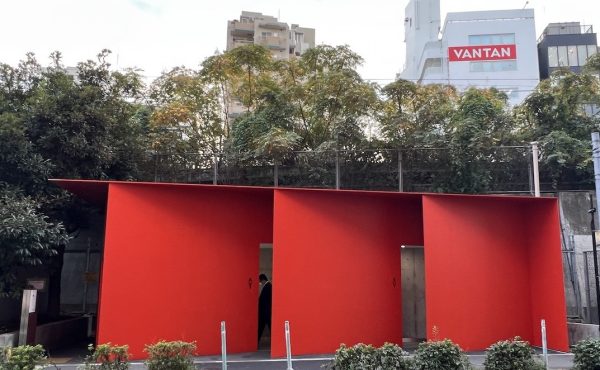At night, the Rosedale Ravine is dark. It’s so dark, in fact, that the Bloor Viaduct is just shapes overhead, cobwebby steel arches and thick square concrete supports. The thin steel wires reaching toward the sky from the top of the bridge are indistinct. There’s no visible trace of the deaths that marred the bridge in public imagining, or the significance of this site for Toronto. But soon, the Luminous Veil will brighten that dark history.
In the kitchen of the echoey townhouse that serves as Dereck Revington’s studio, the architect bends over his MacBook. He’s paging through drawings and simulations that he made to show the City of Toronto what his sculpture would look like if finally lit up. The work, done “essentially on spec,” as one City official put it, is something nobody would do just for the money: hours of simulations showing different ways the “ethereal” light will move in different seasons, the changes of speed and direction when wind moves across the strands and the way it will change across the hours of the day.
When Revington embarked on the task of redesigning the never-completed lights of his sculpture, it was just the latest piece of a passion work that has been with the architect since the late 1990s, when the Bloor Viaduct was known for the number of people who leapt to their deaths from its railings. Revington is a sculptor by inclination, known for what he lovingly calls his “crazy art projects”: unconventional municipal infrastructure, often with light components. With the Veil, he designed a barrier that ended halted the Bloor Viaduct’s growing infamy, but that wasn’t the last of his aspirations. “I thought that I wanted to bring some light into that tremulous void,” he says, “the darkness that has fallen on the bridge as the result of those suicides.” Revington always hoped his design would be finished. When the Veil was initially built, he made sure that it was wired to make lighting possible — if and when the money and the political will came along.
And, finally, they have. The Pan Am Games Legacy Fund is paying for the upper part of the sculpture to be illuminated in July 2015 to coincide with the Games’ torch trip across the viaduct. But Revington’s redesign also included elements under the deck of the bridge, including one that lights up the subway track. Those parts won’t be lit up, a choice made by the city when the full plan, in true Toronto fashion, went over-budget. The announcement was just another small step sideways in the contested life of this public work.
The squabbles over the Luminous Veil are Toronto politics writ small. They represent a cacophony of voices with divergent and sometimes incompatible visions of what the city should be and how it should operate. This struggle demonstrates something essential about Toronto’s approach to public works: the Veil — like the city’s contested subway system, its long-awaited civic museum and its underused waterfront — captures Toronto at its least successful, but also at its most honest. Though events like the Pan Am Games try to portray Toronto as a city united, it is, and it should continue to be, a contested space, full of voices. “This is what a democracy is,” says Revington. What the city needs, however, are voices at the top who can demonstrate commitment to a vision and willingness to build consensus.
Protestors oppose the Veil
The early March air is thick with the aromatic smoke of dissent — tiki torches, pot and tobacco, a haze illuminated by flame — as the Ontario Coalition Against Poverty (OCAP) leads a protest of maybe one hundred people. OCAP is angry that City money is being spent on unnecessary lighting in a time of dwindling homeless shelters and decrepit public housing. Founding OCAP member John Clarke is everywhere, reminding people to keep their torches up, eyeing the cops on bicycles who are following the march, and checking on the banner at its head. When they reach a pedestrian overpass two kilometres south of the Bloor Viaduct, he steps in front of the congregation to vent. “If you want to know what the priorities are of those bastards of the neoliberal city,” he yells, no microphone needed, “look at that.” The protestors follow his finger to the Luminous Veil, shifting their torches. The banner is draped over the railing, imploring the cars below to push for HOMES NOT GAMES. It’s a vignette that OCAP claims is seen by “hundreds” of motorists on the Don Valley Parkway, but it barely makes the news. The next day — the City’s budget day — OCAP will try to present city council with a bill of $461.50 for its actions. The point is to contrast OCAP’s expenditure with the $3.8 million the city is spending to light up only part of the Veil.
Revington flashes anger when asked about those, like OCAP, who say that the Veil lighting is frivolous. Such accusations have come more frequently in recent months. Toronto Star columnist Rosie DiManno blamed the Luminous Veil on “emotionalism,” while OCAP called the illumination “tacky.” He asks, rhetorically, “Why don’t we just have a really ugly, drab, utilitarian city?” After all, the city could have just built a chain-link fence to address the problem of its “suicide bridge.” Even now, a large sign stands near a payphone at each end of the Bloor Viaduct, bearing a phone number for Toronto’s volunteer-run Distress Line. The signs are a legacy of the late 1990s, when the number of jumpers off the viaduct peaked. People began to talk about the viaduct as being Toronto’s suicide landmark in the same breath as San Francisco’s Golden Gate Bridge. Almost 600 people have died by jumping into the Don Valley, and the rate of suicides peaked while the unromantically named “suicide prevention barrier” was being built.
Even in those dire circumstances, the City was divided on whether to build a barrier. Concerns ranged from the bridge’s stunning views being ruined to the amount of money a barrier would cost. People who want to kill themselves will just go elsewhere, it was argued — and some did. But a coalition of mental health organizations led by the Schizophrenia Society of Ontario made a compelling argument that the bridge was a suicide landmark. Although some studies suggest that the barrier didn’t make a difference in the number of people who kill themselves by jumping, the fact remains that Toronto doesn’t have a suicide landmark anymore. The Veil raises the guard rails edging the viaduct to five and a half metres in height. As the latter part of its name suggests, the Veil is almost transparent from a distance, a bundle of eight millimetre railings spaced widely enough that the wooded Rosedale Ravine and the busy Don Valley Parkway below are easily visible. Revington metamorphosed the idea from “chain-link fence” to award-winning sculpture. That the Veil was left unfinished speaks to how much art is underestimated by Toronto, Revington says. OCAP’s words don’t really unsettle him for this reason: “In your absence of knowledge about something, you can call it anything you like.”
The Viaduct is one of our best pieces of civic architecture
That a struggle of this magnitude took place at the Bloor Viaduct is a civic irony. When the bridge was finished in 1919, it was among the largest of its type in North America, giving bragging rights to the city. It also typified concerns that continue to animate civic politics: money, transit, and civic vision while helping to establish the east-west divide that continues to characterize Toronto. The final design crossed the ravine on five arches, designed in the modish Beaux-Arts style. It was one of the first municipal structures to use concrete — the marble of its day — in significant measure, and at one point in the design process was supposed to be entirely concrete. The man best known for driving the viaduct’s construction was R.C. Harris, widely seen as one of the city’s first city-building visionaries. Harris and his bridge were immortalized in Michael Ondaatje’s 1987 novel In The Skin of a Lion. Ondaatje writes, “He loved this viaduct. It was his first child as Head of Public Works, much of it planned before he took over but he bullied it through. It was Harris who envisioned that it could carry not just cars but trains on a lower trestle.” When the viaduct was completed, a fit of post-World War I whimsicality prompted City officials to name it after Britain’s Prince Edward, but the name that stuck was the one that appears on the plans: Bloor Viaduct.
Both businesses and residents on the east side of the viaduct continue to struggle with the intellectual divide posed by the valley, which remains almost one hundred years after it was physically bridged. Though the western end of the Danforth is only three subway stops from Yonge Street, the Danforth Business Improvement Association (BIA) continues to look for ways to bring more visitors to their neighbourhood. Seven years ago, its members — some remembering what it was like when the bridge was a suicide landmark — hit on Revington’s unfinished design. Jennifer Jones, whose dance studio is two buildings east of Broadview, took up the cause of getting the Veil lit and has championed it ever since. In 2008, Jones was interested because she saw the financial possibilities that the only city-owned lighted sculpture presented for the neglected east end. But it quickly turned into something more for the dance teacher. “It’s a testament to life,” she says, “and to honour the fact that the prevention has saved life.”
Pan Am Games brought the funding
Though Revington always hoped his Veil would see the light, it was the BIA who brought the resurrected idea to the City and kept it on the agenda through the reign of three mayors. Jones is terribly disappointed that the entire Veil won’t be illuminated as a Pan Am Games legacy. “That comes from this lack of vision in the city,” she says. “Potholes, housing, all of those things — those are important things and I’m not denying them. But if you’re going to do something, do it.” There’s only one upside Jones can see to lighting the bridge in 2015: “Had they put the lights in back in 2002, they would have been replacing them by now.”
University of Toronto urbanist David Roberts says the Pan Am Games are a “missed opportunity” for Toronto, and he, too, blames lack of vision. The Games are supposed to mobilize money for Toronto, but Roberts says the opportunity isn’t being used, because there’s no clear picture of what the city needs. “[The mayor] could potentially have some of these larger conversations about vision, and how these different pieces fit together, and how the Pan Am Games fit into a long-term vision for the city,” he says. Back in January, Mayor John Tory said he was “troubled, and I’ll put it no stronger than that” by the idea of funding the Veil when the City was having trouble coming up with money for things as pressing as homelessness and as unsexy as potholes. Granted, Tory had only been in office a few months at that point, and was facing money pressure from numerous fronts. Many hoped he would bring positive vision to the city after Rob Ford. But the mayor’s prevarication shows him joining the tradition of civic leaders who pull their punches when it comes to urban infrastructure.
Terry Nicholson, who directs the City’s arts and culture wing, says the lighting wouldn’t be going forward without support from Councillor Paula Fletcher (Ward 30, Toronto-Danforth) and the three other councillors whose wards border the viaduct. After applications for the Pan Am Legacy Fund ended in 2013, $4 million dollars remained in the fund. Then the councillors came to the City and lobbied for the money to light up the bridge, a task whose first quoted price was under $2 million. Thanks to the BIA and Revington, there was a plan ready for execution. Even though it didn’t really fit with the Pan Am Games or other Games legacies, the City took a chance on the idea. Nicholson, who has worked on art for the City in one capacity or another since the 1980s, is excited to see the Veil finally illuminated. He also thinks the undercarriage will eventually be lit. The main issue is that most of the money for Toronto’s public art comes from developers, not the City’s coffers. Those arrangements take a long time to negotiate, and they already proved contentious for this piece of functional art, whose history is littered with failed public-private partnerships. In the end, the City has paid for the whole thing out of pocket, which is a source of outrage for OCAP’s John Clarke but a source of pride for Jennifer Jones. Out of all the public art in the city, the Veil is the biggest piece Toronto owns outright.
If all goes well, on July 4th the Luminous Veil will light up for the first time at sunset, during a ceremony that also involves the Pan Am Games torch relay. The bridge will be closed, and full of people. When the Veil wakes up for the night, there’s a moment when the whole thing glows, and doesn’t respond to temperature or wind. The light is “angelic” in Jennifer Jones’s words, “tacky” in the words of John Clarke. It’s the longest project Dereck Revington has ever been on. It’s been the subject of a lot of opinions. Soon, it will light up, glowing tackily or angelically or just artfully, responding to wind and heat, its shifting colours marking the passage of time on one of Toronto’s finest public works.
Images courtesy of Dereck Revington Studio






4 comments
I walked along the bridge last week as it was undergoing testing. It’s just stunning. It’s worthwhile and in time will come to be regarded as a brilliant idea.
“…the Veil is almost transparent from a distance…”
The looming steel cruciform fenceposts are not transparent from any distance. They look like rows of tank traps hanging off each side of the bridge.
If lighting the thing up will make it prettier, I’m all for it. Imagine if all of the money being blown on the Pan Am games were put into housing the homeless in structures that were as grim and prison-like as the “Luminous Veil.” John Clarke would flip right out, and he’d have a point.
This light-up is a frivolous waste; though sure, coloured lights do look purty. What galls me is that for a decade, we’ve been struggling for a safe bikeway along Bloor/Danforth, and gee, we have to have an Environmental Assessment for a line of paint, and gee, we can’t find that smaller sum for a study of repainting the lane lines for $25,000 a km, So to re-do Bloor from Sherbourne (where the existing bike lanes across the Viaduct end) over to High Park would be $200,000 which was hardly the increase in the consultant’s fees for telling the City how much more it would cost to light things up. So bike safety is NOT a priority for the City, nor is it for those who voted for it, almost all Councillors. We desperately need a single safe east-west route across the City and Bloor/Danforth would assist the subway too. Then to make it all worse, the $3.8M is actually BORROWED money!
The tokenism of adding a dash of green paint near Broadview is something that should have been done with the other upgrades five years ago; and meanwhile, there weren’t repairs made to the bike lane area at Broadview, and they still haven’t managed to seal the gutter of the Viaduct to stop the moisture from seeping into the concrete. Not enough millions in doing preventive maintenance….
I can’t express how wonderful it is to see the veil lit up after all these years. I’m sure I speak for the entire Yolles crew when I say “Bravo!” (PS – Hello Dereck!)